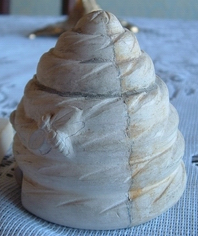|
 
These photos show the original model that dad made in his proposal to the Lions, and he used it to produce dozens of molds with which he and mom would fill the order. They had made several hundreds of the beehives by the time dad left for Alaska in the fall of 1950 but the order was for many hundreds more.
Mom was left to finish the job after he returned to Seward. It was to be the source of money to buy our tickets to follow him the next spring after school was out. She had one medium sized kiln with three shelves, to do the job alone and was pressed for time.
The process was a long complicated one that required, among other things, that the plaster molds be allowed to dry out so that they could absorb water from the ‘slip” (liquified clay) when it was poured. She secured the mold pieces together, poured them full of slip, waited until the clay had dried enough around the outside of the mold, inverted the mold over a vessel to collect the unused slip. Then she had to unfasten the mold elements, carefully remove them from the newly cast piece, trim it carefully with a knife, then set it aside to dry which took several days. After they pieces were dry, she had to sand them to remove elements of the seam that always resulted from multipart casting molds. She would finally fill the kiln with a load of properly dried and sanded pieces and close it after putting in cones of the proper temperature for her purpose. Then she had to carefully ramp up the temperature of the elements suntil the desired heat was reached. Then she had to slowly turn down the temperature to allow things inside to cool slowly. After the temp was off, and the kiln was cold, she could open it and remove the fired pieces, now called bisque.
The next step was to spray glaze onto the bizque pieces, let them dry which didn’t take long and refire them through the same laborious process. A third firing was required for the outside piece of the hive vecause the bees had to be paitned yellow and black. This process went on for months and she finally had to start firing through the night to get the job completed in time. One night, she was too exhausted and slept through her alarm. When she woke up, fully half of the kiln had been destroyed by melted down pieces of ceramics. That made her job harder Determined that she would, she did what she had to do and did deliver the complete finished job on time and received the money to buy three tickets to Seward in the Summer of 1951.
|

